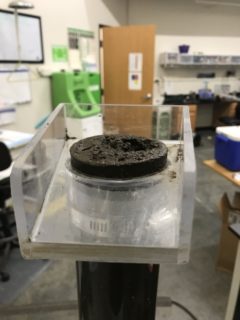by William Hobbs and Siana Wong, Washington State Department of Ecology
Rolf Vinebrooke, University of Alberta
We often hear the question of whether cyanobacteria (sometimes referred to as toxic algae) are a recent phenomenon in certain lakes. Generally, we don’t have the monitoring data to answer this. One possible way to investigate this question is to use the lake sediment record to detail recent changes in the lake and the surrounding watershed. As algae grow and die, they are deposited on the bottom of the lake and accrue year after year. A sediment core that is dated using radioisotopes can provide a detailed record of what was growing in the lake and accumulating year after year.
We recovered a sediment core from Anderson Lake in Jefferson County, Washington, to answer the question of whether cyanobacteria have been present in this lake over the last ~250 years. Anderson Lake is familiar to many in Washington’s limnological community because of its very high toxin concentrations from cyanobacteria. The lake is closed each year from approximately May through October due to public health concerns.

The sediment core is transported back to a lab and sliced into thin sections representing unique dates in the lake’s history.
To investigate the sediment record of a lake, we need to find remains of the algae preserved in the sediment. The soft cell walls of lake algae do not preserve in sediments, but the biochemical interior (pigments) of the algae do. All lake algae have pigmentation. Some pigments are primary photosynthetic compounds (chlorophylls) that are used during photosynthesis, while others are secondary pigments that have a variety of functions, such as UV protection, and are specific to certain types of algae. Once the sediment core is cut into thin slices representing short periods of time, we can extract the pigment remains from the sediment, measure how much of it was present, and infer how prevalent certain types of algae were in the past.
The pigment analysis on Anderson Lake sediments recorded a diverse cyanobacterial community, extending back to at least the mid-1700s. We now know that the physical, and likely chemical (i.e., nutrient), setting of the lake naturally supported a diverse cyanobacterial community. Measured pigments in the sediment representing filamentous (canthaxanthin) and colonial cyanobacteria (myxoxanthin), in addition to general cyanobacterial pigments (zeaxanthin and echinenone), were compatible with observations of modern cyanobacterial blooms.

Historical farming on Anderson Lake in the early 1900s. Cattle grazing can be observed down to the lakeshore. (Photo courtesy of Jefferson County Historical Society, object ID 2005.69.68.)
The accumulation of cyanobacterial pigments increased dramatically from about 1900 to 1970, while farming and cattle grazing occurred on the shore of the lake. In 1969, a state park was established around the lake, and within about 10 years, the cyanobacterial productivity had returned to historical levels. This decreasing trend in cyanobacterial productivity could be in response to reduced nutrient inputs once agricultural activities ceased and/or hydrologic alteration of the lake outlet due to construction of a road just before the park was established.
By understanding some of the long-term ecological changes in the lake, the expectation for any lake management strategy is better understood. For instance, in order for Anderson Lake to support cyanobacteria historically, nutrient concentrations in the water were likely similar to those found in the lake today. Any strategy to control current cyanobacterial growth should acknowledge that nutrient-rich waters are likely to persist in Anderson Lake.










